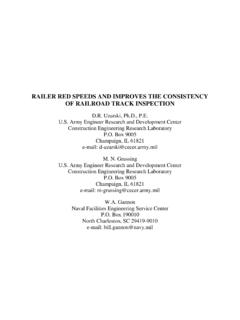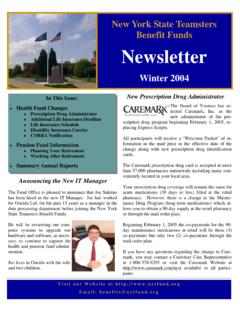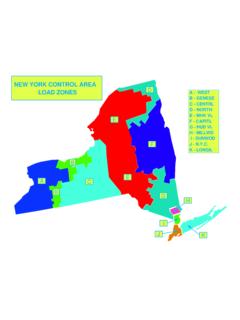Transcription of 15 Years later: Tree-Assisted Creosote Remediation …
1 2015 RAILROAD ENVIRONMENTAL CONFERENCE 15 Years later: Tree-Assisted Creosote Remediation at the Former Tennessee Railroad Rail-Tie Yard in oneida , Tennessee Barry J Harding AECOM Steven R Aufdenkampe Norfolk Southern Railway Mark A Widdowson & John T Novak Virginia Tech 25 Years after the discovery of Creosote nonaqueous-phase liquid (NAPL) venting to a surface waterbody, no further action is required at a legacy rail-tie yard managed by Norfolk Southern s environmental Remediation group. Successful on-site Remediation was accomplished primarily through bulk contaminant mass removal and, secondarily, by natural attenuation of target petroleum hydrocarbons facilitated through rhizodegradation and phytovolatilization processes. A well-documented case study spanning 15years of applied Tree-Assisted Creosote Remediation is presented. The Tennessee Railroad (1913-1973) is a defunct short coal and goods hauling line that historically ran from oneida and Fork Mountain, Tennessee.
2 Creosote -treated railroad ties were supplied from the local oneida Rail-Tie Yard (Site), which operated from 1950 up to 1973. In 1990, during construction activities, Creosote was discovered at the Site, seeping toward a local tributary Pine Creek. The source of the Creosote was identified as being a former Creosote dip pond and an above ground storage tank. The primary remedial effort included removal of approximately 1147 tons of Creosote -impacted soil. However, to address residual contamination, a phytoremediation system consisting of over 1,200 hybrid poplar trees was implemented in 1997-1998 under acceptance from the Tennessee Department of Environment and Conservation (TDEC). The phytoremediation system was installed for hydraulic control of dissolved-phase constituents and to enhance natural biodegradations. In 1999, 2005, and 2006, researchers at Virginia Polytechnic Institute and State University (VirginiaTech), Blacksburg, Virginia documented phytoremediation performance monitoring at the site, including: A hydrogeological analysis and tree evapotranspiration (ET) model for the Site, which predicted a maximum potential ET rate of gallons per day per poplar tree (Loftis, 1999), Evidence of direct volatilization of naphthalene in soil, induced through phytovolatilization (Booth, 2005), Quantification of tree -facilitated naphthalene removal mechanisms based on seven Years of groundwater monitoring, in-situ soil respiration testing, soil microcosm studies, and contaminant uptake through tree core sampling and analysis and stem-flux sampling and analysis (Andersen, 2006).
3 Final performance monitoring work in 2015 included assessment of the health and physical attributes of the existing hybrid poplar tree stand, DNA fingerprinting of the soil microbial community using quantitative polymerase chain reaction (qPCR), assessment of contaminant uptake into tree tissues using tree -core sampling and analysis using solid-phase media samplers, and incremental sampling and analysis of tree rings, using energy-dispersive X-ray spectroscopy. A 15-year study of the project is presented, focusing on lessons learned, regulator acceptance, challenges to Creosote Remediation , and evolution and state of the Tree-Assisted Creosote Remediation .








